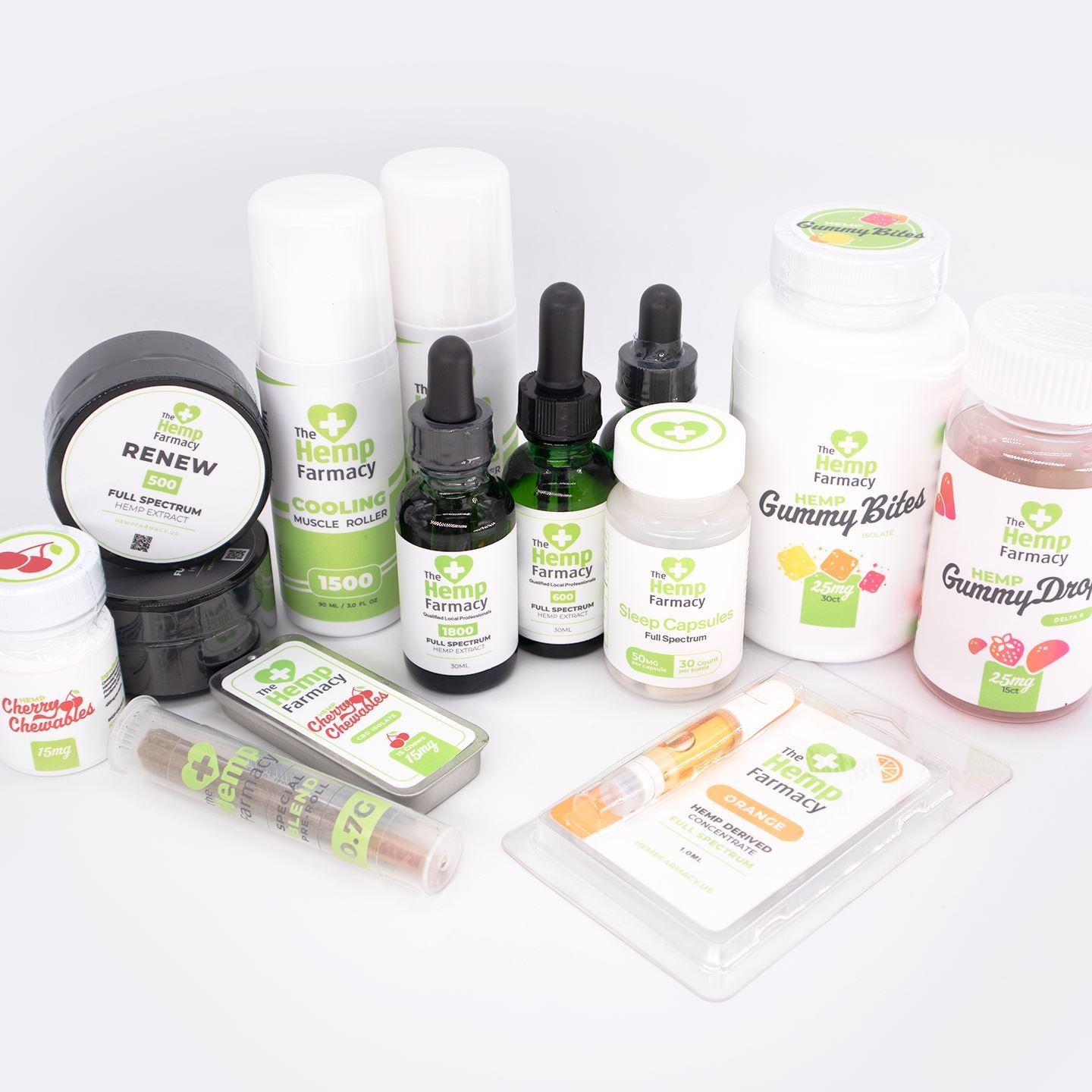
What Type of Hemp Product is Right for You?
Choosing a CBD Delivery Method
The medical benefits of cannabidiol (CBD) are becoming increasingly undeniable. The fantastic ability of CBD and other full spectrum cannabinoids to bind with the endocannabinoid receptors present in the body, facilitates systems’ functions, and maintains an overall balance. It is wise to consider the various delivery methods before choosing a CBD product to find the best fit for you. Each method produces different effects, durations as well as variable bioavailability. As a result, specific forms of consumption may be superior to others depending upon individual factors and the desired outcome.
Bioavailability is defined as the degree to which a compound is absorbed into a living system or is made available in the bloodstream after calculating the absorption rate. Although the rates vary from person to person based on health factors, how the body metabolizes the CBD differently according to the delivery method is paramount in determining the initial dosing and finding your personal "sweet spot."
Narrowing down which forms of CBD delivery allows the most CBD to reach your circulatory system can help decrease the amount being lost through natural bodily processes. The lower the bioavailability, the more considerable the amount of CBD product you will have to administer to produce the desired effect. Therefore, bioavailability, onset time and duration are all important considerations when choosing the right CBD product for you and your needs.
There are four central CBD delivery systems — inhalation, ingestion, sublingual, and topical. Below is a summary of each method and the differences to help decide which one is optimal for you!
Inhalation
Inhalation is known to have one of the highest bioavailabilities of the delivery methods because the cannabinoids are absorbed into the bloodstream through the lungs. Though the effects may not last as long as it does with other methods, there is a quicker onset time due to the lungs' interiors permeability, providing relief almost instantly. There are two quite different inhalation methods, vaporizing and smoking. One significant difference is at what specific temperature the decarboxylation, heating to a particular temperature to activate the cannabinoids, occurs. Inhaling CBD produces bioavailability of around 30%.
Smoking raw hemp involves lighting dried cannabis flower which produces combustion. An advantage of using raw cannabis flower is controlling the strain, source, and cannabinoid content. However, the most significant drawbacks to smoking include coughing and irritation in the lungs, and some of the plant’s CBD literally goes up in smoke.
Vaporizing is generally considered a less harmful option, using a stream of heated air to vaporize the active ingredients in cannabis without combustion (smoke) at a lower temperature. This lower temperature avoids unhealthy byproducts of combustion, like tiny particles of soot that can damage the lungs and hurt the heart.
Vape oil, cannabis concentrate, and dried flower can all be vaporized with the correct equipment. Vaporizing can be accomplished with vape oil in a vape pen, raw flower in a particular type of dry herb vaporizer, or concentrate in a dab rig or pen. The result is a less harsh and robust flavor and vapor compared to smoke. Both smoking and vaping CBD may have high bioavailability, but vaping manages to deliver that CBD more efficiently.
Many vape pens and cartridges are also extremely simple to use and easy to transport. However, it is crucial to purchase vape oils from a trusted company that utilizes safe thinning agents to produce their products, such as naturally occuring terpenes.
Ingestion
Ingestion, or consumption into the digestive tract, includes eating edibles, swallowing oils or tinctures, and taking capsules and tablets by mouth. This method is convenient for many individuals, and the effects are felt for a more extended period than inhalation. It also takes longer to feel the results as it passes through the digestive system, which can take up to two hours. When swallowed, it is absorbed through the gastrointestinal tract and then metabolized in the liver (known as the first-pass metabolism). The digestive tract then redirects the fat-soluble substance to the fatty tissues and throughout the lymphatic system.
The estimated bioavailability for ingestion is relatively low at 10% to 20%. CBD is fat-soluble, so it should be accompanied by something with a high-fat content when taken orally. This combination helps to dissolve CBD more easily into smaller molecules which increases the bioavailability. Studies have found taking it alongside a high-fat meal or snack can increase the concentration of CBD available in your body. Many CBD tinctures utilize carrier oils such as MCT oil, olive oil, or hemp seed oil, providing the extra fat needed for superior absorption.
In addition to helping break down the CBD into easy to absorb molecules, the added fat is also thought to help slow the rate at which CBD leaves the body. For example, when CBD is consumed on an empty stomach, it has been found to leave the body up to 9 times quicker than CBD taken with a meal.
CBD Tinctures and Oils are preferred by many individuals because they come in a variety of concentrations and are efficiently dosed. A CBD tincture is an alcohol-based extract. Alcohol is used as a solvent to extract the natural compounds of the cannabis plant, and it’s also used in the finished product. Many people use the terms CBD tincture and CBD oil interchangeably, but an actual tincture generally has a stronger earthy taste along with a majority alcohol content.
After the desired compounds are extracted in CBD oil production, they’re mixed with the particular carrier oil. CBD carrier oils help to bring the therapeutic components of CBD to different parts of your body, in addition to the benefits the oils may have on their own. The various carrier oils allow you to absorb different amounts of CBD and have varying flavor and shelf life. The more your body can absorb, the more effective and bioavailable it will be.
Olive oil, hemp seed oil, and MCT oil are commonly used carrier oils. MCT is a supplement made from a type of fat called medium-chain triglycerides and can boost cognitive function and increase bioavailability in your body. In addition, MCT molecules are smaller than those in most of the fats you eat because they have been fractionated or divided into smaller parts. These smaller components not only make them easier to digest but allows your body to metabolize them quickly, making MCT the best choice for many individuals.
Capsules and tablets are highly convenient and easy to figure out exactly how much CBD you are taking. This type of individual regimen is user-friendly and maybe more consistent due to the ease of use. Instant release tablets such as Prolifera’s CBD and CBN, add Cannabinol (CBN), another well-known cannabinoid for sleep wellness, and terpenes in a faster-acting product.
Edibles like candy and baked goods are sometimes tricky to determine the exact dosage consumed because the CBD may not be equally distributed throughout the product. For example, a candy bar may not have a homogenous distribution of cannabinoids; if only half of the bar is eaten, one half of the product may be more potent than the other half. On the other hand, gummies are an easier way to take in the therapeutic benefits of CBD because they taste excellent, and the exact dose is determinable as the whole gummy is eaten. CBD can also be added to a wide range of drink supplements, foods, and beverages.
Sublingual
Sublingually (under the tongue), as opposed to ingestion, is the most effective way to absorb CBD oils and tinctures. The effects are longer lasting than inhalation, although not as immediate, once it enters your system. The tiny capillaries under the tongue absorb the tincture more effectively than simply ingesting the oil orally. It is suggested to hold it under your tongue for at least 30 seconds or as long as possible as it absorbs into your bloodstream before swallowing.
The bioavailability of sublingual administration has a great range anywhere from 13%-35%. Therefore, this delivery method’s effects are felt slower than inhalation. However, at roughly 20-30 minutes, it is much faster than ingestion which takes up to two hours.
Topicals
The bioavailability of a topical cream, salve, or transdermal patch is estimated to be very low compared to other methods of use. However, this does not mean that they do not provide relief as the CBD component works differently. CBD applied topically will not enter the bloodstream unless it is in transdermal patch form but instead interacts with the endocannabinoid receptors in the skin and central nervous system. Therefore, topicals are applied directly on areas of the body that are irritated, inflamed, or aching and effectively reduces those issues in targeted areas without going through the bloodstream.
Many CBD consumers find that topicals offer a valuable form of relief, and the effects are usually felt within 20-30 minutes and last several hours. Salves, roll-ons, and sprays which contain menthol, mint, or arnica are said to work more immediately. Understand that most of the data is based on anecdotal evidence, and there is no overall consensus on the exact timing and duration of relief felt.
When choosing your desired consumption method, it's important to consider what would best fit your body, your needs and your lifestyle as each method reaps its own unique benefits. It's also common to utilize different products for different situations you may run into day-to-day.
Written by Judy Ghanem, Hemp Farmacy Content Writer










Leave a comment
This site is protected by hCaptcha and the hCaptcha Privacy Policy and Terms of Service apply.